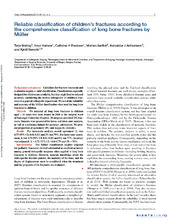Reliable classification of children’s fractures according to the comprehensive classification of long bone fractures by Müller
Meling, Terje; Harboe, Knut; Enoksen, Cathrine H.; Aarflot, Morten; Arthursson, Astvaldur J.; Søreide, Kjetil
Peer reviewed, Journal article
Published version
Permanent lenke
https://hdl.handle.net/1956/6442Utgivelsesdato
2013Metadata
Vis full innførselSamlinger
Originalversjon
https://doi.org/10.3109/17453674.2012.752692Sammendrag
Background and purpose: Guidelines for fracture treatment and evaluation require a valid classification. Classifications especially designed for children are available, but they might lead to reduced accuracy, considering the relative infrequency of childhood fractures in a general orthopedic department. We tested the reliability and accuracy of the Müller classification when used for long bone fractures in children. Methods: We included all long bone fractures in children aged < 16 years who were treated in 2008 at the surgical ward of Stavanger University Hospital. 20 surgeons recorded 232 fractures. Datasets were generated for intra- and inter-rater analysis, as well as a reference dataset for accuracy calculations. We present proportion of agreement (PA) and kappa (K) statistics. Results For intra-rater analysis, overall agreement (Κ) was 0.75 (95% CI: 0.68–0.81) and PA was 79%. For inter-rater assessment, K was 0.71 (95% CI: 0.61–0.80) and PA was 77%. Accuracy was estimated: Κ = 0.72 (95% CI: 0.64–0.79) and PA = 76%. Interpretation: The Müller classification (slightly adjusted for pediatric fractures) showed substantial to excellent accuracy among general orthopedic surgeons when applied to long bone fractures in children. However, separate knowledge about the child-specific fracture pattern, the maturity of the bone, and the degree of displacement must be considered when the treatment and the prognosis of the fractures are evaluated.
